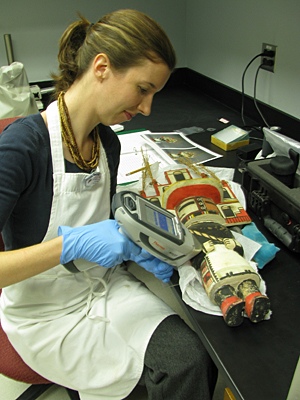
- UD grad interns help preserve mummies, spacesuit, other cultural treasures
- Bringing a saintly portrait back to life in Missouri
- Conserving a knight's shield from ages past
- Käsebier photographs conserved at National Gallery of Canada
- Examining ancient Egyptian mummies at the Walters Art Museum
- Restoring Southwestern pottery at the Arizona State Museum
- Caring for Maryland's first settlement, Armstrong's spacesuit
- Preserving masterpieces at the Walters Art Museum
- 'Big Four' railroad magnate's paintings undergo conservation at Yale
- Studying indigo dyes at the Smithsonian
- Treating a Moorish Islamic ceiling at the Metropolitan Museum of Art
Editor's note: The Winterthur/University of Delaware Program in Art Conservation is one of only five graduate-level conservation programs in the United States. Graduate students in the program spend their third year in an advanced internship at museums and studios around the world.
Here, Meghan McFarlane reports on her work at the Arizona State Museum.
10:13 a.m., March 19, 2009----I'm spending my third year interning in the Preservation Division of the Arizona State Museum under the supervision of objects conservator Nancy Odegaard. The Arizona State Museum houses an impressive collection of Southwestern archaeological and ethnographic artifacts. The museum recently completed work on a state-of-the-art conservation laboratory.
I've spent much of my time to date stabilizing and restoring Southwestern pottery. Some of the more unusual pieces have included pots with indigenous repairs made by tying yucca fibers through holes drilled on either side of the crack, as well as a type specimen bowl, which is the primary artifact used by archaeologists to define that particular style of decoration.
In addition to my work on pottery, I have begun work on Native American basketry and Hopi Kachina dolls. The latter artifact group will be the subject of a technical study in which I will characterize the materials used on Kachina dolls over time using analytical equipment such as X-ray fluorescence and microscopy.


